Evidence-Based Practice Report – Ethical Dilemma
VerifiedAdded on 2022/11/29
|12
|3316
|182
AI Summary
This evidence-based practice report explores the ethical dilemma faced by nurses in healthcare. It discusses conflicts between doctors and nurses, the need for better guidelines, and recommendations for practice change and research.
Contribute Materials
Your contribution can guide someone’s learning journey. Share your
documents today.
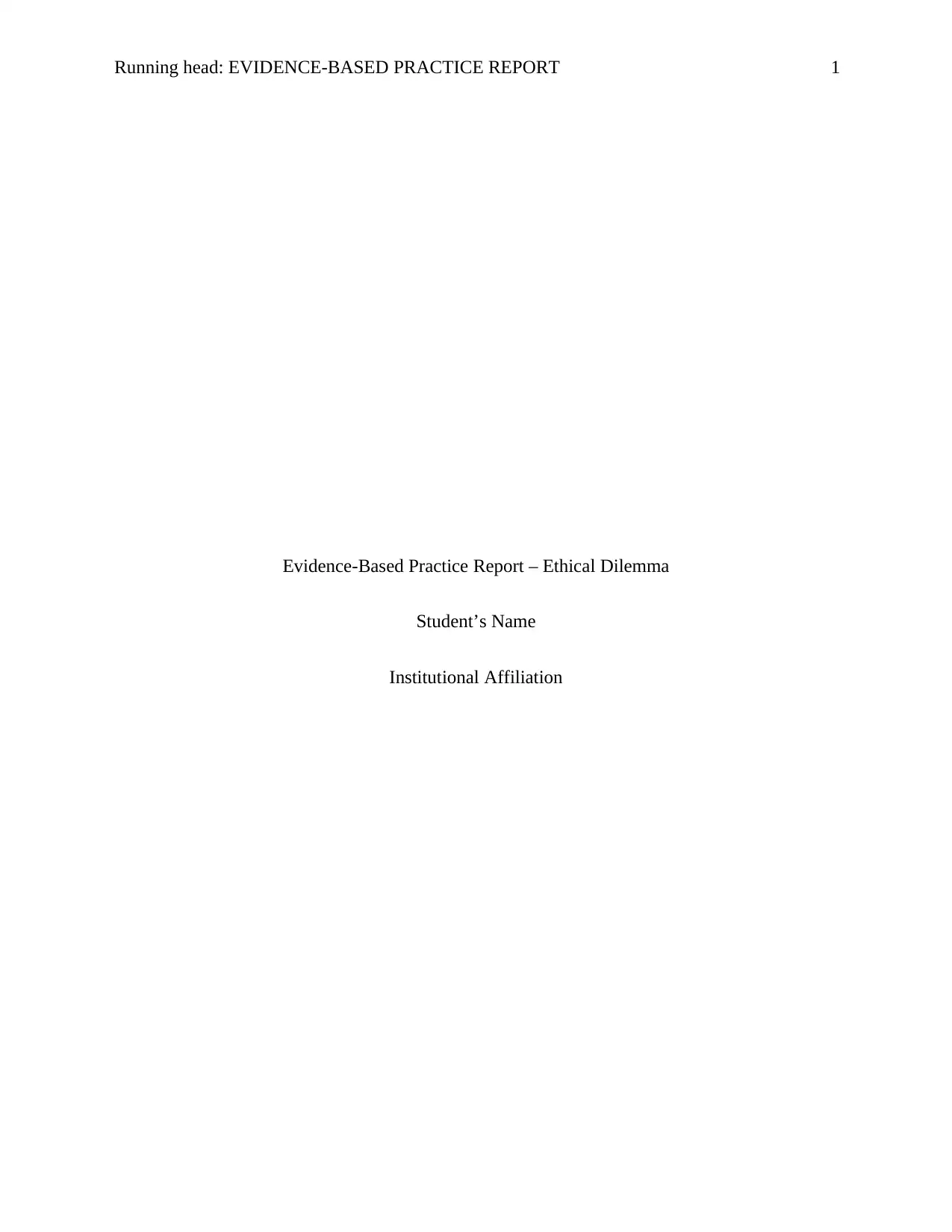
Running head: EVIDENCE-BASED PRACTICE REPORT 1
Evidence-Based Practice Report – Ethical Dilemma
Student’s Name
Institutional Affiliation
Evidence-Based Practice Report – Ethical Dilemma
Student’s Name
Institutional Affiliation
Secure Best Marks with AI Grader
Need help grading? Try our AI Grader for instant feedback on your assignments.
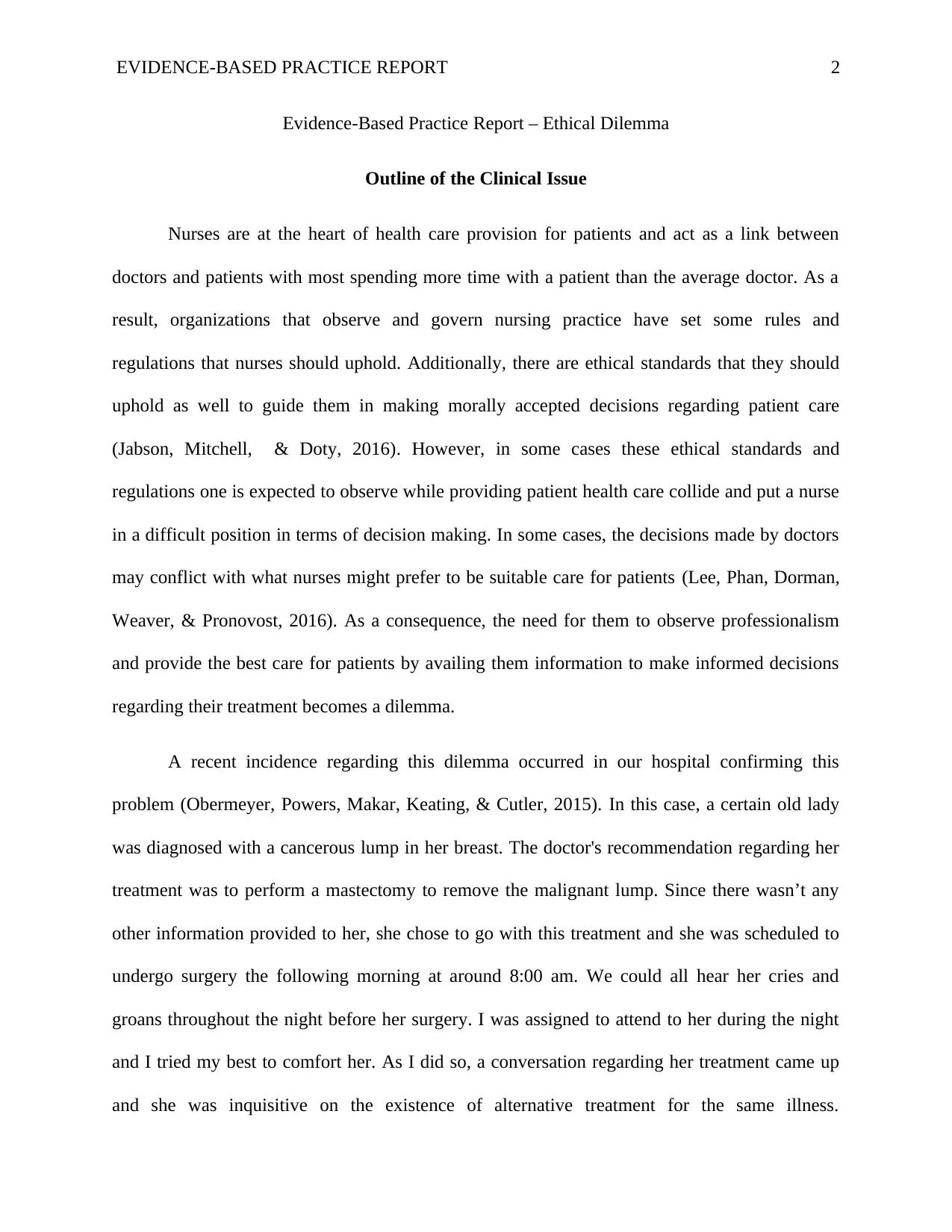
EVIDENCE-BASED PRACTICE REPORT 2
Evidence-Based Practice Report – Ethical Dilemma
Outline of the Clinical Issue
Nurses are at the heart of health care provision for patients and act as a link between
doctors and patients with most spending more time with a patient than the average doctor. As a
result, organizations that observe and govern nursing practice have set some rules and
regulations that nurses should uphold. Additionally, there are ethical standards that they should
uphold as well to guide them in making morally accepted decisions regarding patient care
(Jabson, Mitchell, & Doty, 2016). However, in some cases these ethical standards and
regulations one is expected to observe while providing patient health care collide and put a nurse
in a difficult position in terms of decision making. In some cases, the decisions made by doctors
may conflict with what nurses might prefer to be suitable care for patients (Lee, Phan, Dorman,
Weaver, & Pronovost, 2016). As a consequence, the need for them to observe professionalism
and provide the best care for patients by availing them information to make informed decisions
regarding their treatment becomes a dilemma.
A recent incidence regarding this dilemma occurred in our hospital confirming this
problem (Obermeyer, Powers, Makar, Keating, & Cutler, 2015). In this case, a certain old lady
was diagnosed with a cancerous lump in her breast. The doctor's recommendation regarding her
treatment was to perform a mastectomy to remove the malignant lump. Since there wasn’t any
other information provided to her, she chose to go with this treatment and she was scheduled to
undergo surgery the following morning at around 8:00 am. We could all hear her cries and
groans throughout the night before her surgery. I was assigned to attend to her during the night
and I tried my best to comfort her. As I did so, a conversation regarding her treatment came up
and she was inquisitive on the existence of alternative treatment for the same illness.
Evidence-Based Practice Report – Ethical Dilemma
Outline of the Clinical Issue
Nurses are at the heart of health care provision for patients and act as a link between
doctors and patients with most spending more time with a patient than the average doctor. As a
result, organizations that observe and govern nursing practice have set some rules and
regulations that nurses should uphold. Additionally, there are ethical standards that they should
uphold as well to guide them in making morally accepted decisions regarding patient care
(Jabson, Mitchell, & Doty, 2016). However, in some cases these ethical standards and
regulations one is expected to observe while providing patient health care collide and put a nurse
in a difficult position in terms of decision making. In some cases, the decisions made by doctors
may conflict with what nurses might prefer to be suitable care for patients (Lee, Phan, Dorman,
Weaver, & Pronovost, 2016). As a consequence, the need for them to observe professionalism
and provide the best care for patients by availing them information to make informed decisions
regarding their treatment becomes a dilemma.
A recent incidence regarding this dilemma occurred in our hospital confirming this
problem (Obermeyer, Powers, Makar, Keating, & Cutler, 2015). In this case, a certain old lady
was diagnosed with a cancerous lump in her breast. The doctor's recommendation regarding her
treatment was to perform a mastectomy to remove the malignant lump. Since there wasn’t any
other information provided to her, she chose to go with this treatment and she was scheduled to
undergo surgery the following morning at around 8:00 am. We could all hear her cries and
groans throughout the night before her surgery. I was assigned to attend to her during the night
and I tried my best to comfort her. As I did so, a conversation regarding her treatment came up
and she was inquisitive on the existence of alternative treatment for the same illness.
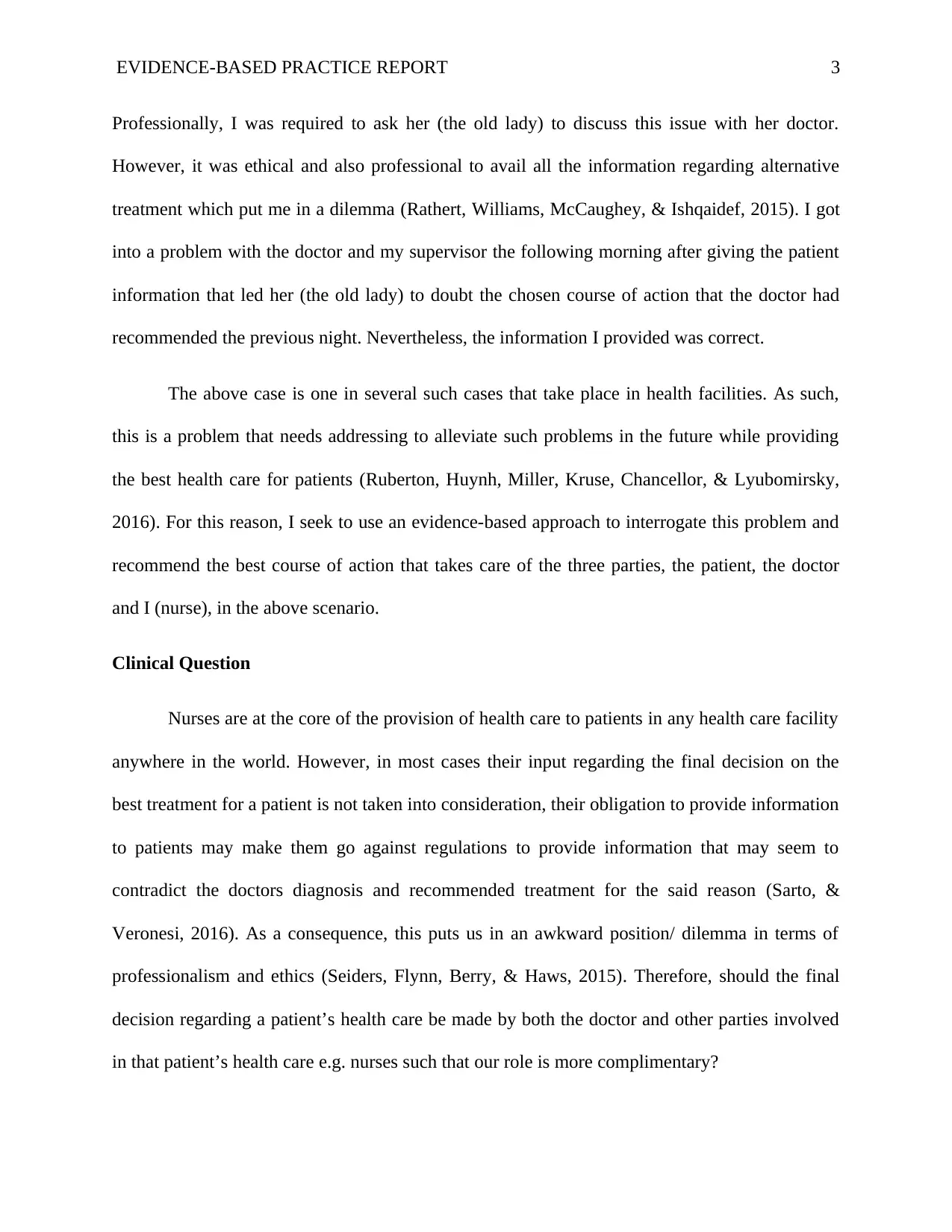
EVIDENCE-BASED PRACTICE REPORT 3
Professionally, I was required to ask her (the old lady) to discuss this issue with her doctor.
However, it was ethical and also professional to avail all the information regarding alternative
treatment which put me in a dilemma (Rathert, Williams, McCaughey, & Ishqaidef, 2015). I got
into a problem with the doctor and my supervisor the following morning after giving the patient
information that led her (the old lady) to doubt the chosen course of action that the doctor had
recommended the previous night. Nevertheless, the information I provided was correct.
The above case is one in several such cases that take place in health facilities. As such,
this is a problem that needs addressing to alleviate such problems in the future while providing
the best health care for patients (Ruberton, Huynh, Miller, Kruse, Chancellor, & Lyubomirsky,
2016). For this reason, I seek to use an evidence-based approach to interrogate this problem and
recommend the best course of action that takes care of the three parties, the patient, the doctor
and I (nurse), in the above scenario.
Clinical Question
Nurses are at the core of the provision of health care to patients in any health care facility
anywhere in the world. However, in most cases their input regarding the final decision on the
best treatment for a patient is not taken into consideration, their obligation to provide information
to patients may make them go against regulations to provide information that may seem to
contradict the doctors diagnosis and recommended treatment for the said reason (Sarto, &
Veronesi, 2016). As a consequence, this puts us in an awkward position/ dilemma in terms of
professionalism and ethics (Seiders, Flynn, Berry, & Haws, 2015). Therefore, should the final
decision regarding a patient’s health care be made by both the doctor and other parties involved
in that patient’s health care e.g. nurses such that our role is more complimentary?
Professionally, I was required to ask her (the old lady) to discuss this issue with her doctor.
However, it was ethical and also professional to avail all the information regarding alternative
treatment which put me in a dilemma (Rathert, Williams, McCaughey, & Ishqaidef, 2015). I got
into a problem with the doctor and my supervisor the following morning after giving the patient
information that led her (the old lady) to doubt the chosen course of action that the doctor had
recommended the previous night. Nevertheless, the information I provided was correct.
The above case is one in several such cases that take place in health facilities. As such,
this is a problem that needs addressing to alleviate such problems in the future while providing
the best health care for patients (Ruberton, Huynh, Miller, Kruse, Chancellor, & Lyubomirsky,
2016). For this reason, I seek to use an evidence-based approach to interrogate this problem and
recommend the best course of action that takes care of the three parties, the patient, the doctor
and I (nurse), in the above scenario.
Clinical Question
Nurses are at the core of the provision of health care to patients in any health care facility
anywhere in the world. However, in most cases their input regarding the final decision on the
best treatment for a patient is not taken into consideration, their obligation to provide information
to patients may make them go against regulations to provide information that may seem to
contradict the doctors diagnosis and recommended treatment for the said reason (Sarto, &
Veronesi, 2016). As a consequence, this puts us in an awkward position/ dilemma in terms of
professionalism and ethics (Seiders, Flynn, Berry, & Haws, 2015). Therefore, should the final
decision regarding a patient’s health care be made by both the doctor and other parties involved
in that patient’s health care e.g. nurses such that our role is more complimentary?
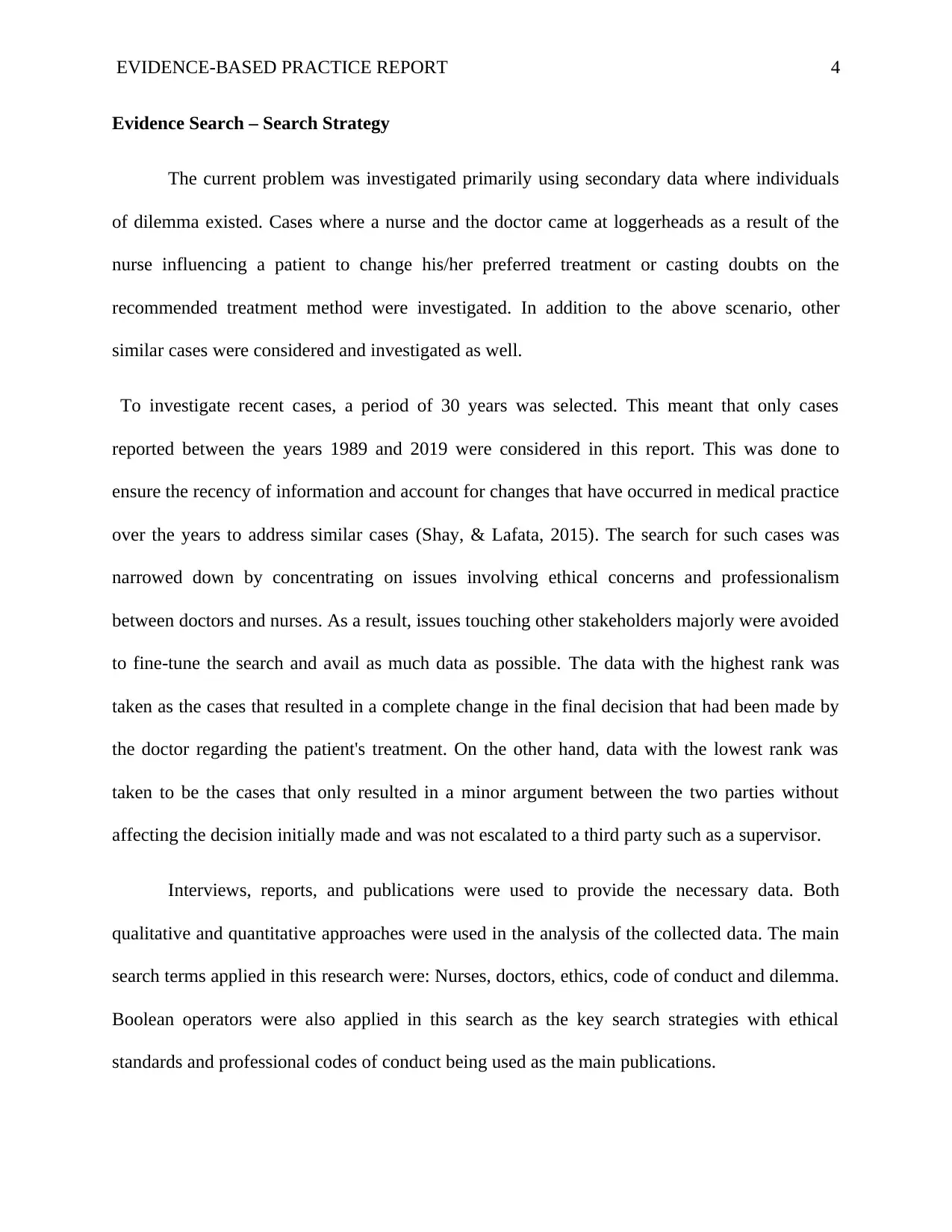
EVIDENCE-BASED PRACTICE REPORT 4
Evidence Search – Search Strategy
The current problem was investigated primarily using secondary data where individuals
of dilemma existed. Cases where a nurse and the doctor came at loggerheads as a result of the
nurse influencing a patient to change his/her preferred treatment or casting doubts on the
recommended treatment method were investigated. In addition to the above scenario, other
similar cases were considered and investigated as well.
To investigate recent cases, a period of 30 years was selected. This meant that only cases
reported between the years 1989 and 2019 were considered in this report. This was done to
ensure the recency of information and account for changes that have occurred in medical practice
over the years to address similar cases (Shay, & Lafata, 2015). The search for such cases was
narrowed down by concentrating on issues involving ethical concerns and professionalism
between doctors and nurses. As a result, issues touching other stakeholders majorly were avoided
to fine-tune the search and avail as much data as possible. The data with the highest rank was
taken as the cases that resulted in a complete change in the final decision that had been made by
the doctor regarding the patient's treatment. On the other hand, data with the lowest rank was
taken to be the cases that only resulted in a minor argument between the two parties without
affecting the decision initially made and was not escalated to a third party such as a supervisor.
Interviews, reports, and publications were used to provide the necessary data. Both
qualitative and quantitative approaches were used in the analysis of the collected data. The main
search terms applied in this research were: Nurses, doctors, ethics, code of conduct and dilemma.
Boolean operators were also applied in this search as the key search strategies with ethical
standards and professional codes of conduct being used as the main publications.
Evidence Search – Search Strategy
The current problem was investigated primarily using secondary data where individuals
of dilemma existed. Cases where a nurse and the doctor came at loggerheads as a result of the
nurse influencing a patient to change his/her preferred treatment or casting doubts on the
recommended treatment method were investigated. In addition to the above scenario, other
similar cases were considered and investigated as well.
To investigate recent cases, a period of 30 years was selected. This meant that only cases
reported between the years 1989 and 2019 were considered in this report. This was done to
ensure the recency of information and account for changes that have occurred in medical practice
over the years to address similar cases (Shay, & Lafata, 2015). The search for such cases was
narrowed down by concentrating on issues involving ethical concerns and professionalism
between doctors and nurses. As a result, issues touching other stakeholders majorly were avoided
to fine-tune the search and avail as much data as possible. The data with the highest rank was
taken as the cases that resulted in a complete change in the final decision that had been made by
the doctor regarding the patient's treatment. On the other hand, data with the lowest rank was
taken to be the cases that only resulted in a minor argument between the two parties without
affecting the decision initially made and was not escalated to a third party such as a supervisor.
Interviews, reports, and publications were used to provide the necessary data. Both
qualitative and quantitative approaches were used in the analysis of the collected data. The main
search terms applied in this research were: Nurses, doctors, ethics, code of conduct and dilemma.
Boolean operators were also applied in this search as the key search strategies with ethical
standards and professional codes of conduct being used as the main publications.
Secure Best Marks with AI Grader
Need help grading? Try our AI Grader for instant feedback on your assignments.
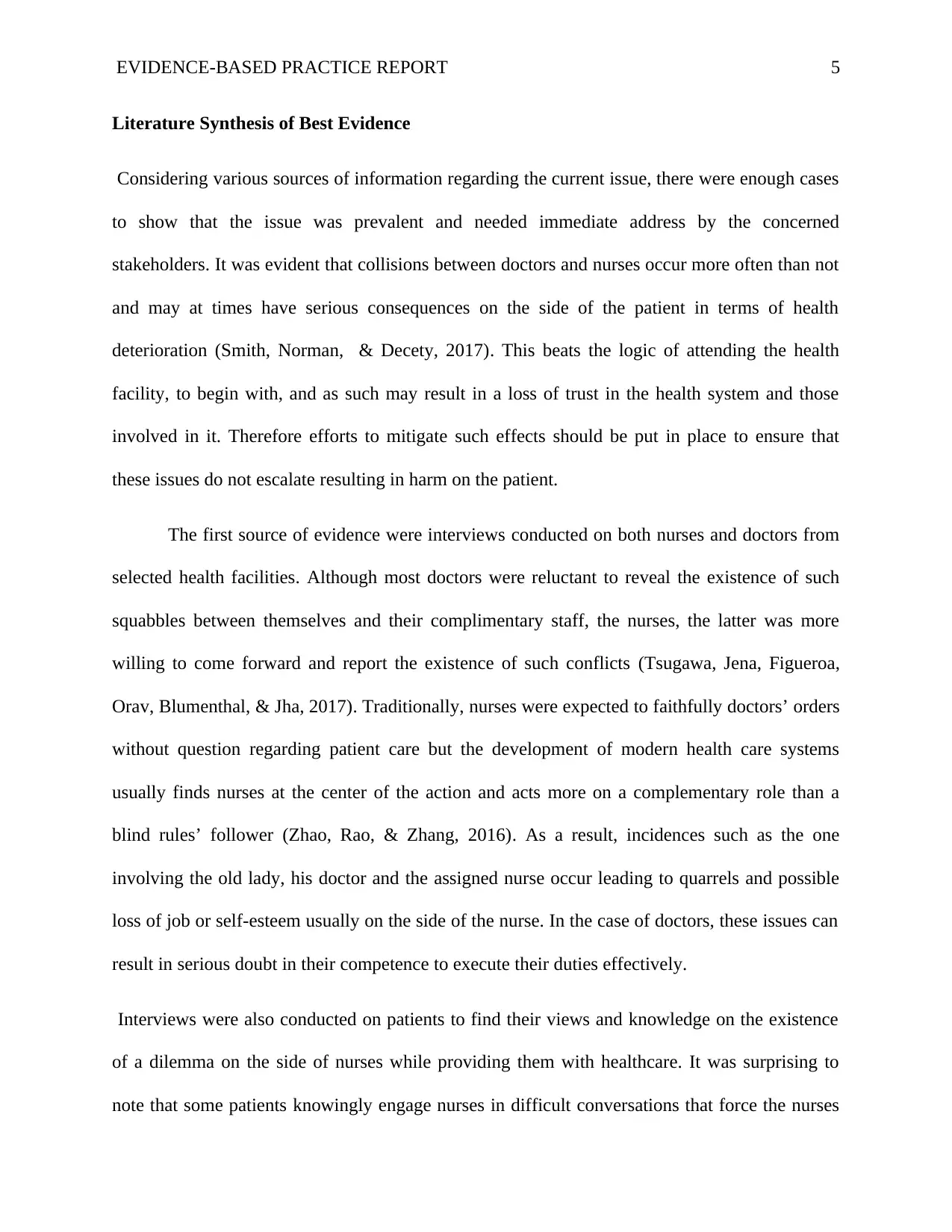
EVIDENCE-BASED PRACTICE REPORT 5
Literature Synthesis of Best Evidence
Considering various sources of information regarding the current issue, there were enough cases
to show that the issue was prevalent and needed immediate address by the concerned
stakeholders. It was evident that collisions between doctors and nurses occur more often than not
and may at times have serious consequences on the side of the patient in terms of health
deterioration (Smith, Norman, & Decety, 2017). This beats the logic of attending the health
facility, to begin with, and as such may result in a loss of trust in the health system and those
involved in it. Therefore efforts to mitigate such effects should be put in place to ensure that
these issues do not escalate resulting in harm on the patient.
The first source of evidence were interviews conducted on both nurses and doctors from
selected health facilities. Although most doctors were reluctant to reveal the existence of such
squabbles between themselves and their complimentary staff, the nurses, the latter was more
willing to come forward and report the existence of such conflicts (Tsugawa, Jena, Figueroa,
Orav, Blumenthal, & Jha, 2017). Traditionally, nurses were expected to faithfully doctors’ orders
without question regarding patient care but the development of modern health care systems
usually finds nurses at the center of the action and acts more on a complementary role than a
blind rules’ follower (Zhao, Rao, & Zhang, 2016). As a result, incidences such as the one
involving the old lady, his doctor and the assigned nurse occur leading to quarrels and possible
loss of job or self-esteem usually on the side of the nurse. In the case of doctors, these issues can
result in serious doubt in their competence to execute their duties effectively.
Interviews were also conducted on patients to find their views and knowledge on the existence
of a dilemma on the side of nurses while providing them with healthcare. It was surprising to
note that some patients knowingly engage nurses in difficult conversations that force the nurses
Literature Synthesis of Best Evidence
Considering various sources of information regarding the current issue, there were enough cases
to show that the issue was prevalent and needed immediate address by the concerned
stakeholders. It was evident that collisions between doctors and nurses occur more often than not
and may at times have serious consequences on the side of the patient in terms of health
deterioration (Smith, Norman, & Decety, 2017). This beats the logic of attending the health
facility, to begin with, and as such may result in a loss of trust in the health system and those
involved in it. Therefore efforts to mitigate such effects should be put in place to ensure that
these issues do not escalate resulting in harm on the patient.
The first source of evidence were interviews conducted on both nurses and doctors from
selected health facilities. Although most doctors were reluctant to reveal the existence of such
squabbles between themselves and their complimentary staff, the nurses, the latter was more
willing to come forward and report the existence of such conflicts (Tsugawa, Jena, Figueroa,
Orav, Blumenthal, & Jha, 2017). Traditionally, nurses were expected to faithfully doctors’ orders
without question regarding patient care but the development of modern health care systems
usually finds nurses at the center of the action and acts more on a complementary role than a
blind rules’ follower (Zhao, Rao, & Zhang, 2016). As a result, incidences such as the one
involving the old lady, his doctor and the assigned nurse occur leading to quarrels and possible
loss of job or self-esteem usually on the side of the nurse. In the case of doctors, these issues can
result in serious doubt in their competence to execute their duties effectively.
Interviews were also conducted on patients to find their views and knowledge on the existence
of a dilemma on the side of nurses while providing them with healthcare. It was surprising to
note that some patients knowingly engage nurses in difficult conversations that force the nurses
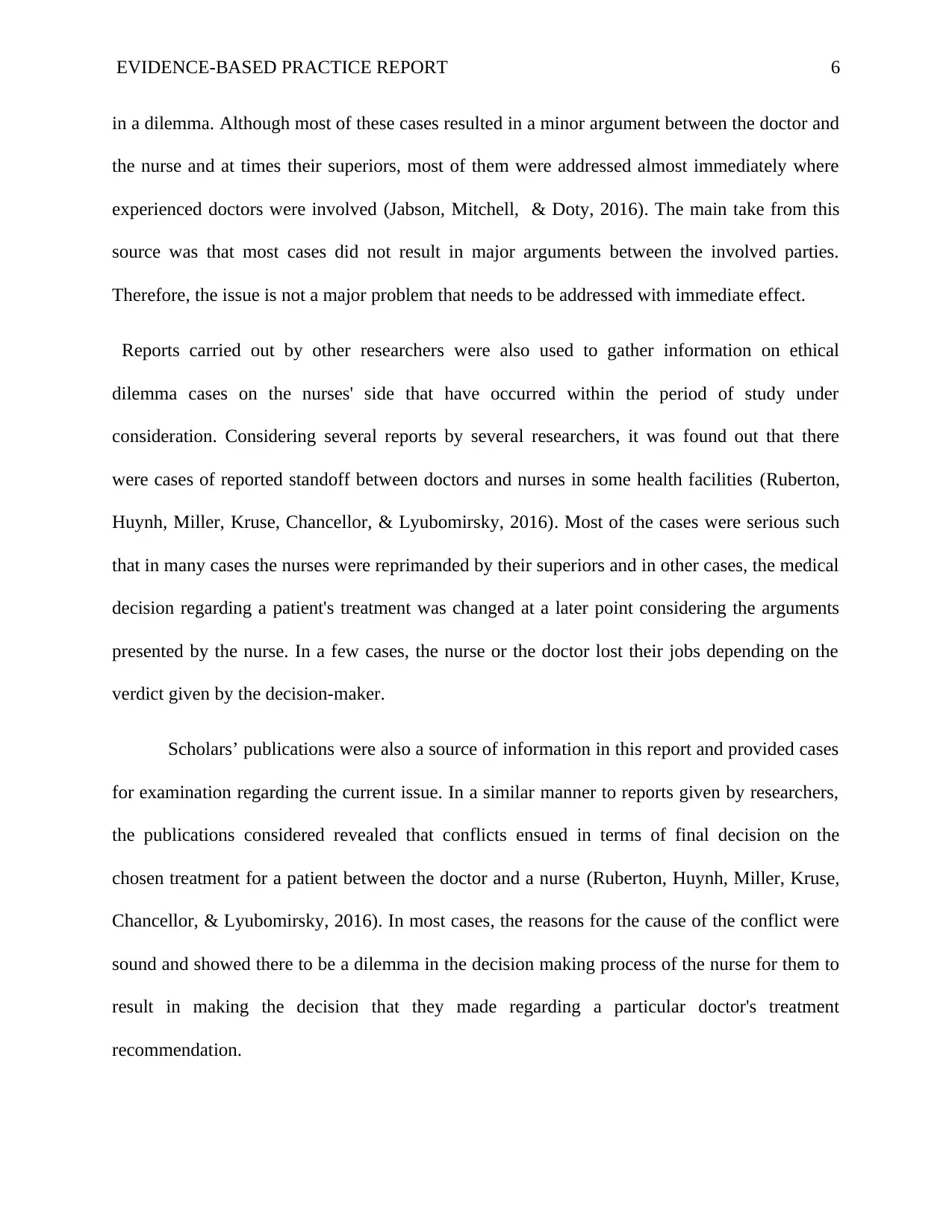
EVIDENCE-BASED PRACTICE REPORT 6
in a dilemma. Although most of these cases resulted in a minor argument between the doctor and
the nurse and at times their superiors, most of them were addressed almost immediately where
experienced doctors were involved (Jabson, Mitchell, & Doty, 2016). The main take from this
source was that most cases did not result in major arguments between the involved parties.
Therefore, the issue is not a major problem that needs to be addressed with immediate effect.
Reports carried out by other researchers were also used to gather information on ethical
dilemma cases on the nurses' side that have occurred within the period of study under
consideration. Considering several reports by several researchers, it was found out that there
were cases of reported standoff between doctors and nurses in some health facilities (Ruberton,
Huynh, Miller, Kruse, Chancellor, & Lyubomirsky, 2016). Most of the cases were serious such
that in many cases the nurses were reprimanded by their superiors and in other cases, the medical
decision regarding a patient's treatment was changed at a later point considering the arguments
presented by the nurse. In a few cases, the nurse or the doctor lost their jobs depending on the
verdict given by the decision-maker.
Scholars’ publications were also a source of information in this report and provided cases
for examination regarding the current issue. In a similar manner to reports given by researchers,
the publications considered revealed that conflicts ensued in terms of final decision on the
chosen treatment for a patient between the doctor and a nurse (Ruberton, Huynh, Miller, Kruse,
Chancellor, & Lyubomirsky, 2016). In most cases, the reasons for the cause of the conflict were
sound and showed there to be a dilemma in the decision making process of the nurse for them to
result in making the decision that they made regarding a particular doctor's treatment
recommendation.
in a dilemma. Although most of these cases resulted in a minor argument between the doctor and
the nurse and at times their superiors, most of them were addressed almost immediately where
experienced doctors were involved (Jabson, Mitchell, & Doty, 2016). The main take from this
source was that most cases did not result in major arguments between the involved parties.
Therefore, the issue is not a major problem that needs to be addressed with immediate effect.
Reports carried out by other researchers were also used to gather information on ethical
dilemma cases on the nurses' side that have occurred within the period of study under
consideration. Considering several reports by several researchers, it was found out that there
were cases of reported standoff between doctors and nurses in some health facilities (Ruberton,
Huynh, Miller, Kruse, Chancellor, & Lyubomirsky, 2016). Most of the cases were serious such
that in many cases the nurses were reprimanded by their superiors and in other cases, the medical
decision regarding a patient's treatment was changed at a later point considering the arguments
presented by the nurse. In a few cases, the nurse or the doctor lost their jobs depending on the
verdict given by the decision-maker.
Scholars’ publications were also a source of information in this report and provided cases
for examination regarding the current issue. In a similar manner to reports given by researchers,
the publications considered revealed that conflicts ensued in terms of final decision on the
chosen treatment for a patient between the doctor and a nurse (Ruberton, Huynh, Miller, Kruse,
Chancellor, & Lyubomirsky, 2016). In most cases, the reasons for the cause of the conflict were
sound and showed there to be a dilemma in the decision making process of the nurse for them to
result in making the decision that they made regarding a particular doctor's treatment
recommendation.
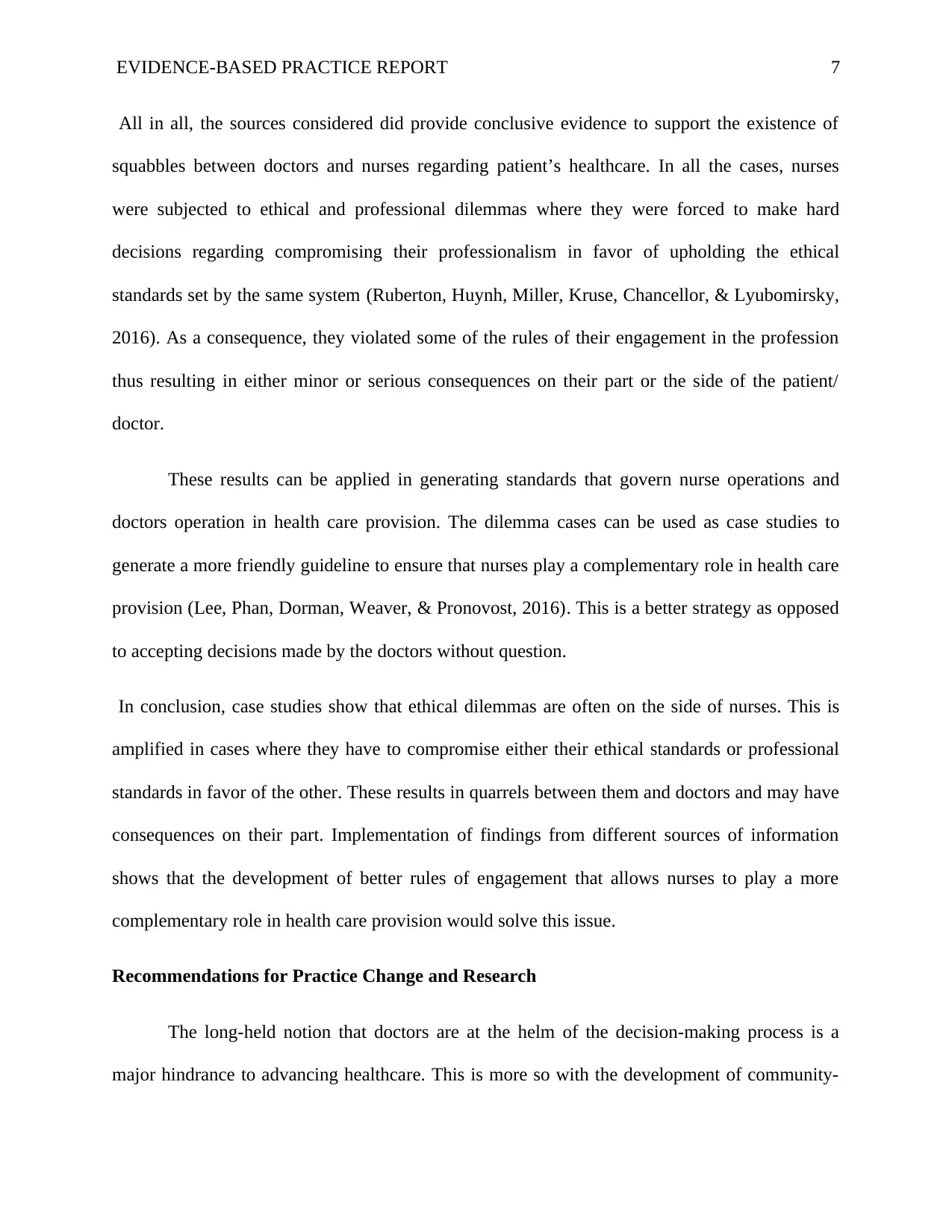
EVIDENCE-BASED PRACTICE REPORT 7
All in all, the sources considered did provide conclusive evidence to support the existence of
squabbles between doctors and nurses regarding patient’s healthcare. In all the cases, nurses
were subjected to ethical and professional dilemmas where they were forced to make hard
decisions regarding compromising their professionalism in favor of upholding the ethical
standards set by the same system (Ruberton, Huynh, Miller, Kruse, Chancellor, & Lyubomirsky,
2016). As a consequence, they violated some of the rules of their engagement in the profession
thus resulting in either minor or serious consequences on their part or the side of the patient/
doctor.
These results can be applied in generating standards that govern nurse operations and
doctors operation in health care provision. The dilemma cases can be used as case studies to
generate a more friendly guideline to ensure that nurses play a complementary role in health care
provision (Lee, Phan, Dorman, Weaver, & Pronovost, 2016). This is a better strategy as opposed
to accepting decisions made by the doctors without question.
In conclusion, case studies show that ethical dilemmas are often on the side of nurses. This is
amplified in cases where they have to compromise either their ethical standards or professional
standards in favor of the other. These results in quarrels between them and doctors and may have
consequences on their part. Implementation of findings from different sources of information
shows that the development of better rules of engagement that allows nurses to play a more
complementary role in health care provision would solve this issue.
Recommendations for Practice Change and Research
The long-held notion that doctors are at the helm of the decision-making process is a
major hindrance to advancing healthcare. This is more so with the development of community-
All in all, the sources considered did provide conclusive evidence to support the existence of
squabbles between doctors and nurses regarding patient’s healthcare. In all the cases, nurses
were subjected to ethical and professional dilemmas where they were forced to make hard
decisions regarding compromising their professionalism in favor of upholding the ethical
standards set by the same system (Ruberton, Huynh, Miller, Kruse, Chancellor, & Lyubomirsky,
2016). As a consequence, they violated some of the rules of their engagement in the profession
thus resulting in either minor or serious consequences on their part or the side of the patient/
doctor.
These results can be applied in generating standards that govern nurse operations and
doctors operation in health care provision. The dilemma cases can be used as case studies to
generate a more friendly guideline to ensure that nurses play a complementary role in health care
provision (Lee, Phan, Dorman, Weaver, & Pronovost, 2016). This is a better strategy as opposed
to accepting decisions made by the doctors without question.
In conclusion, case studies show that ethical dilemmas are often on the side of nurses. This is
amplified in cases where they have to compromise either their ethical standards or professional
standards in favor of the other. These results in quarrels between them and doctors and may have
consequences on their part. Implementation of findings from different sources of information
shows that the development of better rules of engagement that allows nurses to play a more
complementary role in health care provision would solve this issue.
Recommendations for Practice Change and Research
The long-held notion that doctors are at the helm of the decision-making process is a
major hindrance to advancing healthcare. This is more so with the development of community-
Paraphrase This Document
Need a fresh take? Get an instant paraphrase of this document with our AI Paraphraser
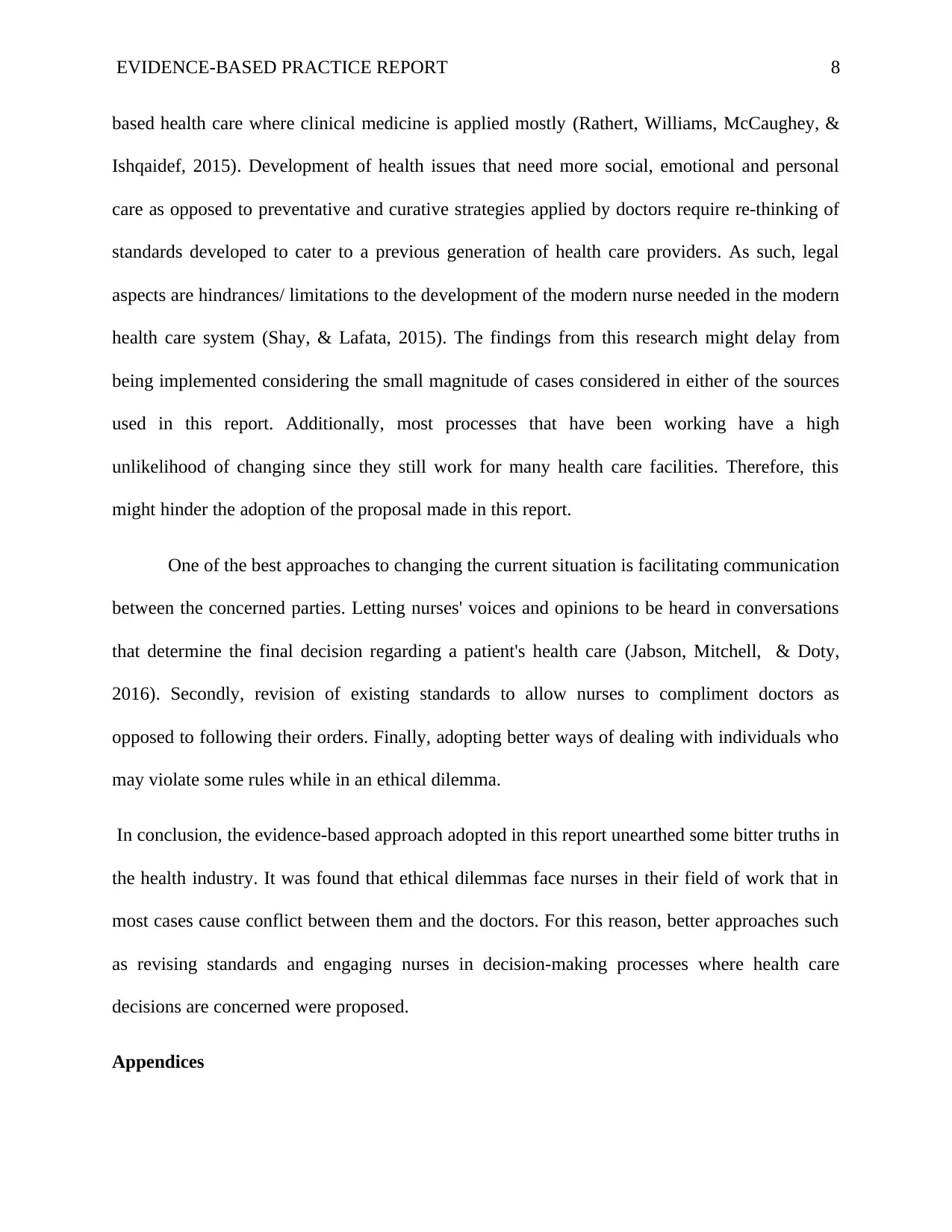
EVIDENCE-BASED PRACTICE REPORT 8
based health care where clinical medicine is applied mostly (Rathert, Williams, McCaughey, &
Ishqaidef, 2015). Development of health issues that need more social, emotional and personal
care as opposed to preventative and curative strategies applied by doctors require re-thinking of
standards developed to cater to a previous generation of health care providers. As such, legal
aspects are hindrances/ limitations to the development of the modern nurse needed in the modern
health care system (Shay, & Lafata, 2015). The findings from this research might delay from
being implemented considering the small magnitude of cases considered in either of the sources
used in this report. Additionally, most processes that have been working have a high
unlikelihood of changing since they still work for many health care facilities. Therefore, this
might hinder the adoption of the proposal made in this report.
One of the best approaches to changing the current situation is facilitating communication
between the concerned parties. Letting nurses' voices and opinions to be heard in conversations
that determine the final decision regarding a patient's health care (Jabson, Mitchell, & Doty,
2016). Secondly, revision of existing standards to allow nurses to compliment doctors as
opposed to following their orders. Finally, adopting better ways of dealing with individuals who
may violate some rules while in an ethical dilemma.
In conclusion, the evidence-based approach adopted in this report unearthed some bitter truths in
the health industry. It was found that ethical dilemmas face nurses in their field of work that in
most cases cause conflict between them and the doctors. For this reason, better approaches such
as revising standards and engaging nurses in decision-making processes where health care
decisions are concerned were proposed.
Appendices
based health care where clinical medicine is applied mostly (Rathert, Williams, McCaughey, &
Ishqaidef, 2015). Development of health issues that need more social, emotional and personal
care as opposed to preventative and curative strategies applied by doctors require re-thinking of
standards developed to cater to a previous generation of health care providers. As such, legal
aspects are hindrances/ limitations to the development of the modern nurse needed in the modern
health care system (Shay, & Lafata, 2015). The findings from this research might delay from
being implemented considering the small magnitude of cases considered in either of the sources
used in this report. Additionally, most processes that have been working have a high
unlikelihood of changing since they still work for many health care facilities. Therefore, this
might hinder the adoption of the proposal made in this report.
One of the best approaches to changing the current situation is facilitating communication
between the concerned parties. Letting nurses' voices and opinions to be heard in conversations
that determine the final decision regarding a patient's health care (Jabson, Mitchell, & Doty,
2016). Secondly, revision of existing standards to allow nurses to compliment doctors as
opposed to following their orders. Finally, adopting better ways of dealing with individuals who
may violate some rules while in an ethical dilemma.
In conclusion, the evidence-based approach adopted in this report unearthed some bitter truths in
the health industry. It was found that ethical dilemmas face nurses in their field of work that in
most cases cause conflict between them and the doctors. For this reason, better approaches such
as revising standards and engaging nurses in decision-making processes where health care
decisions are concerned were proposed.
Appendices
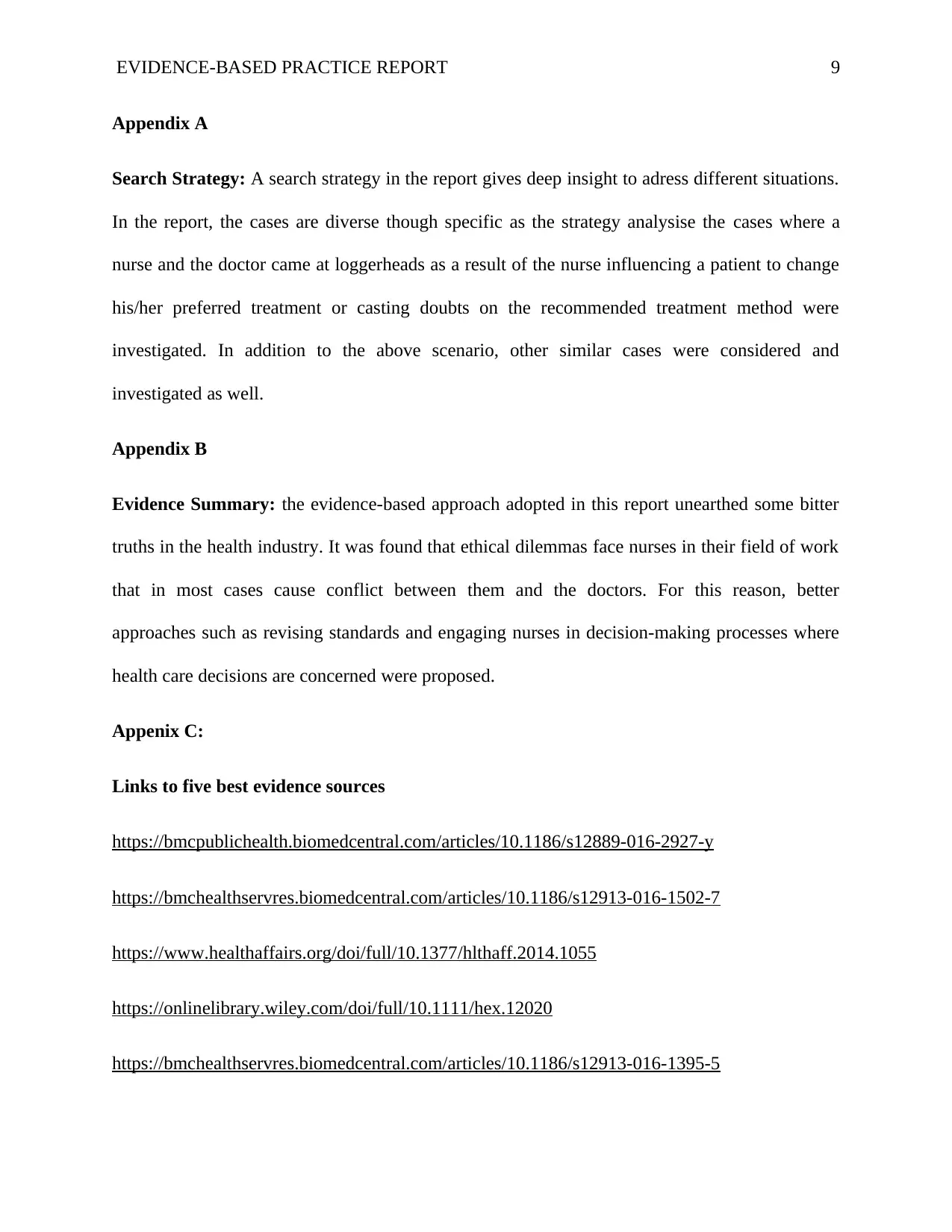
EVIDENCE-BASED PRACTICE REPORT 9
Appendix A
Search Strategy: A search strategy in the report gives deep insight to adress different situations.
In the report, the cases are diverse though specific as the strategy analysise the cases where a
nurse and the doctor came at loggerheads as a result of the nurse influencing a patient to change
his/her preferred treatment or casting doubts on the recommended treatment method were
investigated. In addition to the above scenario, other similar cases were considered and
investigated as well.
Appendix B
Evidence Summary: the evidence-based approach adopted in this report unearthed some bitter
truths in the health industry. It was found that ethical dilemmas face nurses in their field of work
that in most cases cause conflict between them and the doctors. For this reason, better
approaches such as revising standards and engaging nurses in decision-making processes where
health care decisions are concerned were proposed.
Appenix C:
Links to five best evidence sources
https://bmcpublichealth.biomedcentral.com/articles/10.1186/s12889-016-2927-y
https://bmchealthservres.biomedcentral.com/articles/10.1186/s12913-016-1502-7
https://www.healthaffairs.org/doi/full/10.1377/hlthaff.2014.1055
https://onlinelibrary.wiley.com/doi/full/10.1111/hex.12020
https://bmchealthservres.biomedcentral.com/articles/10.1186/s12913-016-1395-5
Appendix A
Search Strategy: A search strategy in the report gives deep insight to adress different situations.
In the report, the cases are diverse though specific as the strategy analysise the cases where a
nurse and the doctor came at loggerheads as a result of the nurse influencing a patient to change
his/her preferred treatment or casting doubts on the recommended treatment method were
investigated. In addition to the above scenario, other similar cases were considered and
investigated as well.
Appendix B
Evidence Summary: the evidence-based approach adopted in this report unearthed some bitter
truths in the health industry. It was found that ethical dilemmas face nurses in their field of work
that in most cases cause conflict between them and the doctors. For this reason, better
approaches such as revising standards and engaging nurses in decision-making processes where
health care decisions are concerned were proposed.
Appenix C:
Links to five best evidence sources
https://bmcpublichealth.biomedcentral.com/articles/10.1186/s12889-016-2927-y
https://bmchealthservres.biomedcentral.com/articles/10.1186/s12913-016-1502-7
https://www.healthaffairs.org/doi/full/10.1377/hlthaff.2014.1055
https://onlinelibrary.wiley.com/doi/full/10.1111/hex.12020
https://bmchealthservres.biomedcentral.com/articles/10.1186/s12913-016-1395-5

EVIDENCE-BASED PRACTICE REPORT
10
Appendix D
Critical appraisal of highest level of evidence
The data with the highest rank was taken as the cases that resulted in a complete change in the
final decision that had been made by the doctor regarding the patient's treatment. On the other
hand, data with the lowest rank was taken to be the cases that only resulted in a minor argument
between the two parties without affecting the decision initially made and was not escalated to a
third party such as a supervisor.
10
Appendix D
Critical appraisal of highest level of evidence
The data with the highest rank was taken as the cases that resulted in a complete change in the
final decision that had been made by the doctor regarding the patient's treatment. On the other
hand, data with the lowest rank was taken to be the cases that only resulted in a minor argument
between the two parties without affecting the decision initially made and was not escalated to a
third party such as a supervisor.
Secure Best Marks with AI Grader
Need help grading? Try our AI Grader for instant feedback on your assignments.
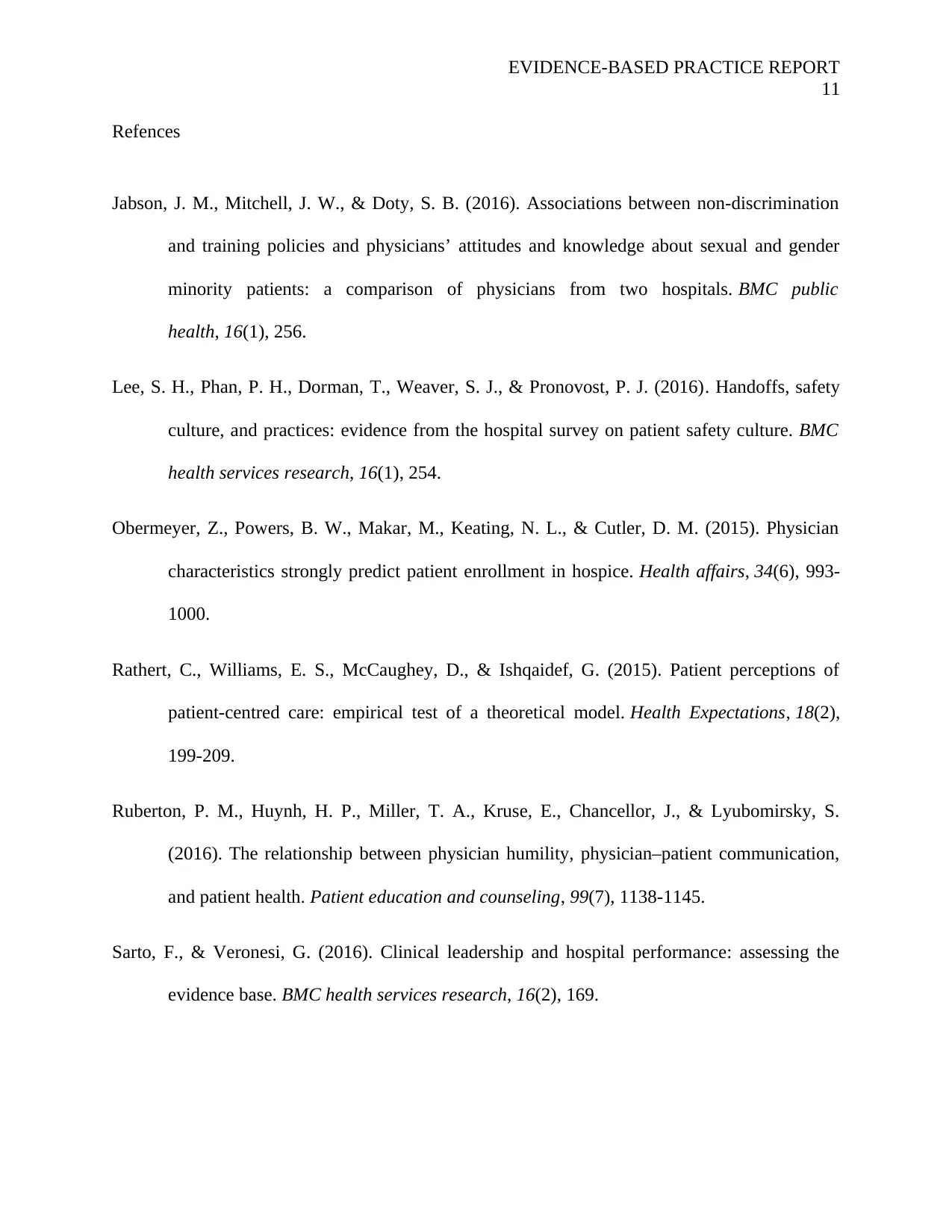
EVIDENCE-BASED PRACTICE REPORT
11
Refences
Jabson, J. M., Mitchell, J. W., & Doty, S. B. (2016). Associations between non-discrimination
and training policies and physicians’ attitudes and knowledge about sexual and gender
minority patients: a comparison of physicians from two hospitals. BMC public
health, 16(1), 256.
Lee, S. H., Phan, P. H., Dorman, T., Weaver, S. J., & Pronovost, P. J. (2016). Handoffs, safety
culture, and practices: evidence from the hospital survey on patient safety culture. BMC
health services research, 16(1), 254.
Obermeyer, Z., Powers, B. W., Makar, M., Keating, N. L., & Cutler, D. M. (2015). Physician
characteristics strongly predict patient enrollment in hospice. Health affairs, 34(6), 993-
1000.
Rathert, C., Williams, E. S., McCaughey, D., & Ishqaidef, G. (2015). Patient perceptions of
patient‐centred care: empirical test of a theoretical model. Health Expectations, 18(2),
199-209.
Ruberton, P. M., Huynh, H. P., Miller, T. A., Kruse, E., Chancellor, J., & Lyubomirsky, S.
(2016). The relationship between physician humility, physician–patient communication,
and patient health. Patient education and counseling, 99(7), 1138-1145.
Sarto, F., & Veronesi, G. (2016). Clinical leadership and hospital performance: assessing the
evidence base. BMC health services research, 16(2), 169.
11
Refences
Jabson, J. M., Mitchell, J. W., & Doty, S. B. (2016). Associations between non-discrimination
and training policies and physicians’ attitudes and knowledge about sexual and gender
minority patients: a comparison of physicians from two hospitals. BMC public
health, 16(1), 256.
Lee, S. H., Phan, P. H., Dorman, T., Weaver, S. J., & Pronovost, P. J. (2016). Handoffs, safety
culture, and practices: evidence from the hospital survey on patient safety culture. BMC
health services research, 16(1), 254.
Obermeyer, Z., Powers, B. W., Makar, M., Keating, N. L., & Cutler, D. M. (2015). Physician
characteristics strongly predict patient enrollment in hospice. Health affairs, 34(6), 993-
1000.
Rathert, C., Williams, E. S., McCaughey, D., & Ishqaidef, G. (2015). Patient perceptions of
patient‐centred care: empirical test of a theoretical model. Health Expectations, 18(2),
199-209.
Ruberton, P. M., Huynh, H. P., Miller, T. A., Kruse, E., Chancellor, J., & Lyubomirsky, S.
(2016). The relationship between physician humility, physician–patient communication,
and patient health. Patient education and counseling, 99(7), 1138-1145.
Sarto, F., & Veronesi, G. (2016). Clinical leadership and hospital performance: assessing the
evidence base. BMC health services research, 16(2), 169.
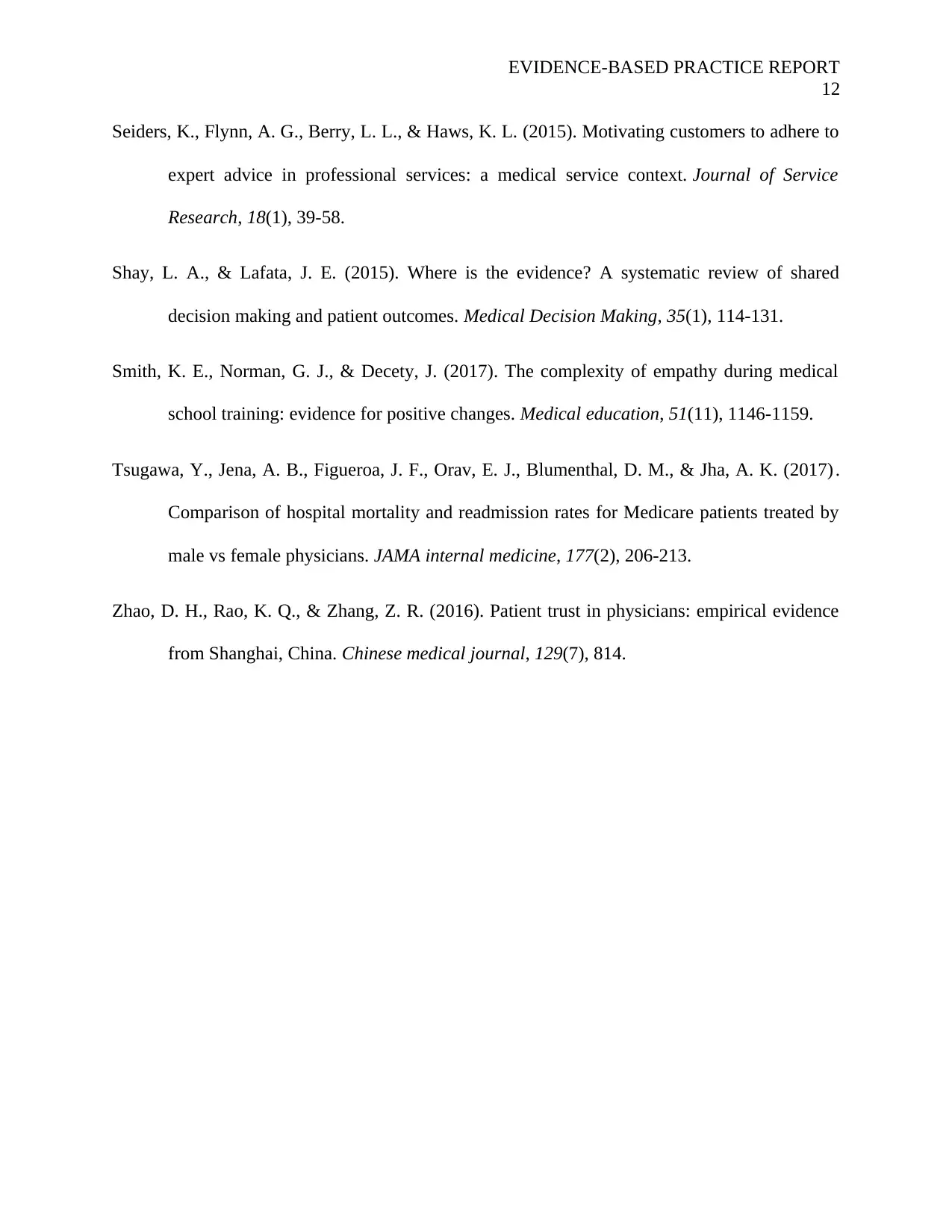
EVIDENCE-BASED PRACTICE REPORT
12
Seiders, K., Flynn, A. G., Berry, L. L., & Haws, K. L. (2015). Motivating customers to adhere to
expert advice in professional services: a medical service context. Journal of Service
Research, 18(1), 39-58.
Shay, L. A., & Lafata, J. E. (2015). Where is the evidence? A systematic review of shared
decision making and patient outcomes. Medical Decision Making, 35(1), 114-131.
Smith, K. E., Norman, G. J., & Decety, J. (2017). The complexity of empathy during medical
school training: evidence for positive changes. Medical education, 51(11), 1146-1159.
Tsugawa, Y., Jena, A. B., Figueroa, J. F., Orav, E. J., Blumenthal, D. M., & Jha, A. K. (2017) .
Comparison of hospital mortality and readmission rates for Medicare patients treated by
male vs female physicians. JAMA internal medicine, 177(2), 206-213.
Zhao, D. H., Rao, K. Q., & Zhang, Z. R. (2016). Patient trust in physicians: empirical evidence
from Shanghai, China. Chinese medical journal, 129(7), 814.
12
Seiders, K., Flynn, A. G., Berry, L. L., & Haws, K. L. (2015). Motivating customers to adhere to
expert advice in professional services: a medical service context. Journal of Service
Research, 18(1), 39-58.
Shay, L. A., & Lafata, J. E. (2015). Where is the evidence? A systematic review of shared
decision making and patient outcomes. Medical Decision Making, 35(1), 114-131.
Smith, K. E., Norman, G. J., & Decety, J. (2017). The complexity of empathy during medical
school training: evidence for positive changes. Medical education, 51(11), 1146-1159.
Tsugawa, Y., Jena, A. B., Figueroa, J. F., Orav, E. J., Blumenthal, D. M., & Jha, A. K. (2017) .
Comparison of hospital mortality and readmission rates for Medicare patients treated by
male vs female physicians. JAMA internal medicine, 177(2), 206-213.
Zhao, D. H., Rao, K. Q., & Zhang, Z. R. (2016). Patient trust in physicians: empirical evidence
from Shanghai, China. Chinese medical journal, 129(7), 814.
1 out of 12
Related Documents
Your All-in-One AI-Powered Toolkit for Academic Success.
+13062052269
info@desklib.com
Available 24*7 on WhatsApp / Email
![[object Object]](/_next/static/media/star-bottom.7253800d.svg)
Unlock your academic potential
© 2024 | Zucol Services PVT LTD | All rights reserved.





